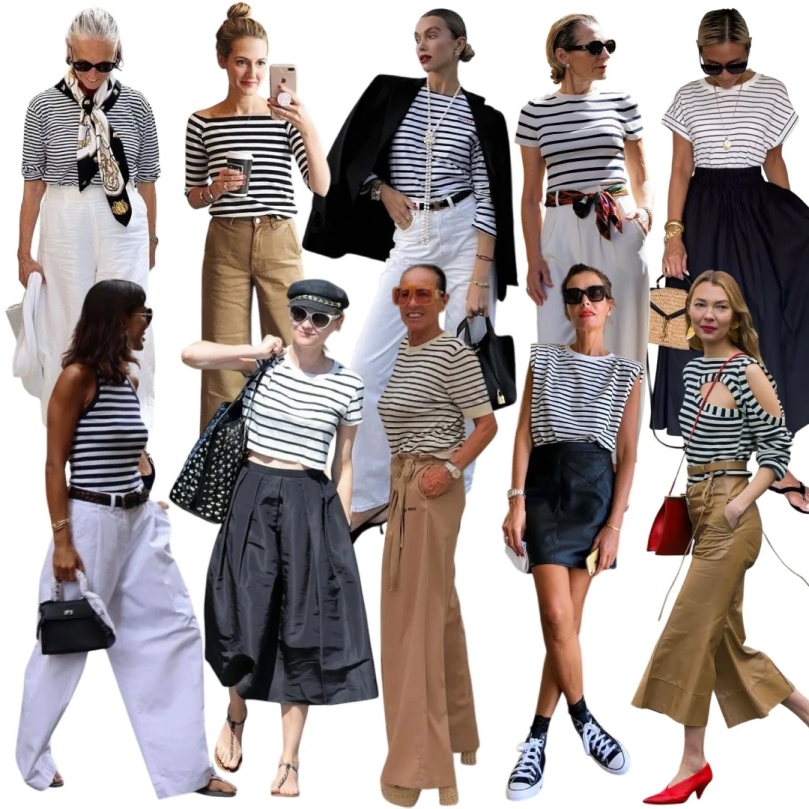Patterns are more than just decoration in fashion. They influence how clothing interacts with the body, how proportions are perceived, and even how individuals express identity. Among the most enduring choices are stripes, checks, and prints. Each has its own history, cultural associations, and visual effects, making them essential tools for both designers and consumers. As these patterns cycle through global trends, the question arises: which one suits whom?
The Enduring Appeal of Stripes
Stripes have been a staple in fashion for centuries, valued for their ability to reshape the body’s appearance. Vertical stripes create a lengthening effect, giving the illusion of added height and a slimmer frame. They are widely used in formal wear and business attire where refinement is key. Horizontal stripes, by contrast, broaden the chest and shoulders, adding balance to slender figures. Even the width of the stripe alters the impression: narrow stripes feel polished, while bold, wide stripes are often associated with casual or youthful energy. Their adaptability ensures that stripes remain relevant across both professional wardrobes and leisurewear.
Checks as a Symbol of Structure
Checks are often associated with tradition, but they continue to evolve in contemporary fashion. Small-scale patterns such as gingham offer a neat, approachable look suitable for everyday wear, while large checks or tartans deliver a statement of strength and confidence. The scale and contrast of checks influence how they shape the upper body: subtle designs flatter without overwhelming, whereas oversized checks can emphasize width. Designers also use fabric choice to redefine checks—stiff cotton conveys formality, while soft wool or blends make the same pattern feel relaxed. This balance between structure and flexibility explains why checks have never gone out of style.
Prints as a Medium of Expression
Prints break away from uniformity, offering endless variety and creativity. From floral motifs to abstract graphics, prints speak directly to personality. Small, repetitive prints provide texture and subtlety, making them suitable for daily office wear. Larger, bolder prints create focal points, particularly in evening or resort fashion. Placement is crucial: a striking print on the chest draws attention upward, while designs concentrated at the waist can shift body proportions. Many fashion houses also rely on signature prints as part of their branding, turning motifs into recognizable elements that strengthen identity.
Considering Body Shapes in Pattern Choices
Fashion experts often emphasize that body type should play a central role in guiding pattern selection, as the right design can subtly enhance or balance one’s natural proportions. For example, petite individuals generally benefit from vertical stripes or smaller, delicate prints, since these patterns visually elongate the frame and create a refined, streamlined silhouette without overwhelming the wearer. On the other hand, those with broader shoulders or fuller figures often achieve greater balance by choosing understated checks or fine stripes, which help soften width while still offering visual interest. Slender or tall figures, by contrast, are particularly well-suited to horizontal stripes and larger checks, as these designs can introduce a sense of volume, add presence, and prevent the figure from appearing overly elongated. Beyond aesthetics, understanding these dynamics allows consumers to make clothing choices that highlight their strengths and bring harmony to their overall look. At the same time, designers who are mindful of these principles can better tailor their collections, ensuring they cater to a diverse range of body types and preferences, ultimately making fashion more inclusive and versatile.
Practical Insights for Designers and Shoppers
Beyond aesthetics, practical considerations shape how patterns function in real wardrobes. Designers test samples on mannequins and models to ensure patterns do not distort when worn. Retailers also adapt scale and color to market demands: subtle tones sell strongly in professional settings, while bright, bold designs capture seasonal and youth-oriented markets. Mixing patterns is possible but requires care—pairing one bold design with a neutral counterpart prevents visual overload. Cultural associations must also be considered, as certain patterns like tartans, florals, or animal prints carry symbolic meanings that affect consumer response.
Conclusion
Stripes, checks, and prints may appear simple, but their impact extends far beyond surface design. They shape perception, highlight or balance body proportions, and communicate personality. Stripes provide timeless structure, checks offer balance and tradition, and prints deliver individuality and creativity. For both designers and consumers, understanding these effects ensures that clothing is not only stylish but also functional and flattering. As fashion continues to evolve, these patterns will remain central to how people express themselves through what they wear.
Post time: Oct-14-2025









